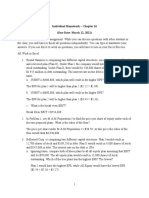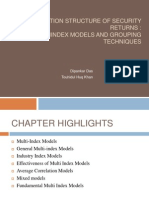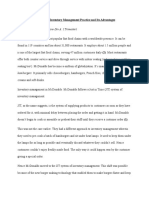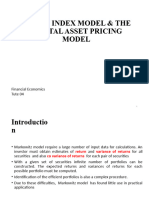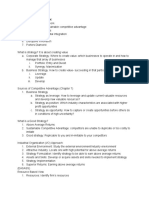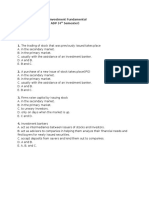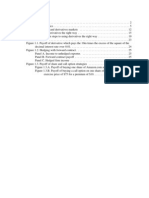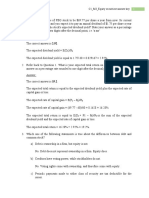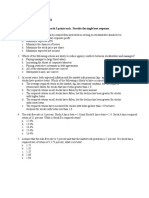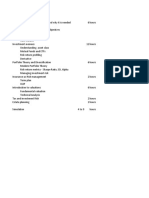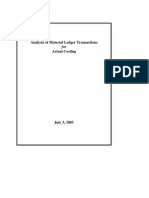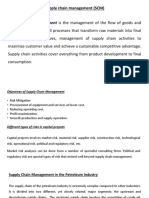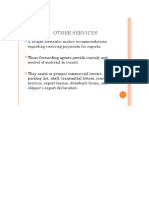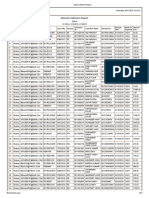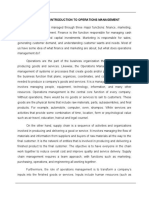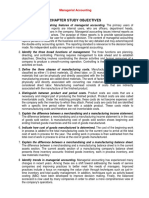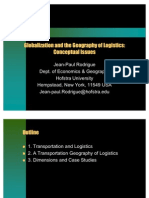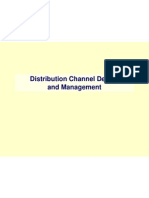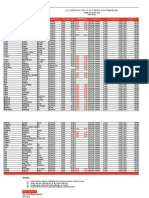0 ratings0% found this document useful (0 votes)
445 viewsCostco - 5 Forces
Costco - 5 Forces
Uploaded by
Aditya JandialCostco's business model relies on membership fees to compensate for low profit margins from product sales. It cuts costs through its supply chain, personal label products, and limited stock-keeping units. Porter's five forces analysis finds that competition from rivals and bargaining power of buyers present challenges, but threats of substitution and new entry are limited given Costco's scale and brand. Overall, Costco's model of low prices financed by memberships remains appealing despite competitive pressures.
Copyright:
© All Rights Reserved
Available Formats
Download as DOCX, PDF, TXT or read online from Scribd
Costco - 5 Forces
Costco - 5 Forces
Uploaded by
Aditya Jandial0 ratings0% found this document useful (0 votes)
445 views2 pagesCostco's business model relies on membership fees to compensate for low profit margins from product sales. It cuts costs through its supply chain, personal label products, and limited stock-keeping units. Porter's five forces analysis finds that competition from rivals and bargaining power of buyers present challenges, but threats of substitution and new entry are limited given Costco's scale and brand. Overall, Costco's model of low prices financed by memberships remains appealing despite competitive pressures.
Original Title
Costco_5 forces
Copyright
© © All Rights Reserved
Available Formats
DOCX, PDF, TXT or read online from Scribd
Share this document
Did you find this document useful?
Is this content inappropriate?
Costco's business model relies on membership fees to compensate for low profit margins from product sales. It cuts costs through its supply chain, personal label products, and limited stock-keeping units. Porter's five forces analysis finds that competition from rivals and bargaining power of buyers present challenges, but threats of substitution and new entry are limited given Costco's scale and brand. Overall, Costco's model of low prices financed by memberships remains appealing despite competitive pressures.
Copyright:
© All Rights Reserved
Available Formats
Download as DOCX, PDF, TXT or read online from Scribd
Download as docx, pdf, or txt
0 ratings0% found this document useful (0 votes)
445 views2 pagesCostco - 5 Forces
Costco - 5 Forces
Uploaded by
Aditya JandialCostco's business model relies on membership fees to compensate for low profit margins from product sales. It cuts costs through its supply chain, personal label products, and limited stock-keeping units. Porter's five forces analysis finds that competition from rivals and bargaining power of buyers present challenges, but threats of substitution and new entry are limited given Costco's scale and brand. Overall, Costco's model of low prices financed by memberships remains appealing despite competitive pressures.
Copyright:
© All Rights Reserved
Available Formats
Download as DOCX, PDF, TXT or read online from Scribd
Download as docx, pdf, or txt
You are on page 1of 2
What is Costco’s business model (i.e.
key components and “blueprint” for delivering a valuable
product or service in a way that will be profitable, that is, a “money maker”)? Is it appealing, given
the five-forces? Why or Why not?
Costco Wholesale Corp. is a US multinational, headquartered in Washington, operating in the business of
membership-only warehouse clubs. The firm has its roots in the Price Club warehouse that was
established in 1976 and is currently the second largest retailer in the world. The firm is well recognized in
the wholesale market as a cost effective solution. The mission statement is “to provide quality goods and
services at the lowest possible prices” and this stands out as the key component of the firm’s business
model.
The business is able to provide economical products owing to the nice business model:
a) Fixed revenue stream: Costco is a membership business which means it can compensate for low
cost with the fixed membership charges. This means that the firm is able to meet the low margins
from sales of packaged products by fixed income
b) Supply chain: The firm has been pretty success in cutting down the costs from supply chain
wastage. The firm picks most of the raw material directly from manufacturer and gets it directly
stored to wholesale joints thus cutting down the overall costs while maintaining quality.
c) Personal Label: Personal label products are a good source of higher margins and Costco is
looking to expand the sales from personal labels and improving margins.
d) SKU range: Since the firm is catering the wholesale business segment, they keep a much lower
number of SKUs than other retails thus keeping a tab on packaging and transport cost. Lower
number of SKUs also allow the firm to better negotiate with manufacturers.
Porter’s five forces is a tool that uses the impact of external forces on the business of the firm.
a) Threat of competition: The business faces high level of threat from competitors owing to the
wide range of players in the market like Walmart, Sam’s club etc. All these chains look to offer
best prices and hence have limited standalone competitive positioning.
b) Bargaining power of suppliers: The business has heavy churn for the available products and
since the firm is a heavy consumer of all products, the suppliers have limited bargaining power
with the business.
c) Bargaining power of buyers: The buyers is the strongest force in the industry owing to the low
switching cost between different sales units. This makes it important for the firm to focus on
advertising.
d) Threat of substitutes: There is limited scope for new substitutes to disrupt the market and hence
the force has less competition.
e) Threat of new entrants: The business needs a well-established supply chain, strong positioning
and brand recall amongst customers. For new players, it is a bit difficult to establish this and
hence there is limited threat from new players.
Based on the impact from all these forces, Costco still has a wide potential and the firms is still a good bet
considering that it is able to maintain its positioning as the provider of quality good at economical prices.
You might also like
- Foundational Theories and Techniques for Risk Management, A Guide for Professional Risk Managers in Financial Services - Part II - Financial InstrumentsFrom EverandFoundational Theories and Techniques for Risk Management, A Guide for Professional Risk Managers in Financial Services - Part II - Financial InstrumentsNo ratings yet
- Chapter 14Document31 pagesChapter 14Huang Wei (Jane)No ratings yet
- Quiz 1 Corporate Finance 1 Chapter's 1 To 3 Multiple ChoiceDocument11 pagesQuiz 1 Corporate Finance 1 Chapter's 1 To 3 Multiple ChoiceHeba Omar100% (1)
- FIN Chapter 16Document3 pagesFIN Chapter 16Dj JablonskiNo ratings yet
- FINS3616 Chapter 2 SummaryDocument5 pagesFINS3616 Chapter 2 SummaryShruti IyengarNo ratings yet
- Set B Multiple Choice, Chapter 24 - Capital Investment AnalysisDocument2 pagesSet B Multiple Choice, Chapter 24 - Capital Investment AnalysisJohn Carlos DoringoNo ratings yet
- The Correlation Structure of Security Returns: Multiindex Models and Grouping TechniquesDocument26 pagesThe Correlation Structure of Security Returns: Multiindex Models and Grouping TechniquessaminbdNo ratings yet
- Doze 1Document14 pagesDoze 1Saad RashidNo ratings yet
- Assignment 2 QuestionDocument8 pagesAssignment 2 QuestionJanarthanan Siva KumarNo ratings yet
- McDonalds Inventory Management PracticeDocument4 pagesMcDonalds Inventory Management PracticePiyush DewanNo ratings yet
- Testbank - Multinational Business Finance - Chapter 1Document11 pagesTestbank - Multinational Business Finance - Chapter 1Uyen Nhi NguyenNo ratings yet
- FIN 432 - Investment Analysis and Management Review Notes For Midterm ExamDocument15 pagesFIN 432 - Investment Analysis and Management Review Notes For Midterm ExamPhuc Hong PhamNo ratings yet
- Single Index Model & The Capital Asset Pricing ModelDocument75 pagesSingle Index Model & The Capital Asset Pricing ModelPrathiba PereraNo ratings yet
- Tutorial 5 - SolutionsDocument8 pagesTutorial 5 - SolutionsHa PhiNo ratings yet
- Reading 1 The Behavioral Biases of IndividualsDocument7 pagesReading 1 The Behavioral Biases of Individualsriham.goel142No ratings yet
- Chapter 8: Corporate Strategy: Vertical Integration and DiversificationDocument12 pagesChapter 8: Corporate Strategy: Vertical Integration and DiversificationnourNo ratings yet
- Fixed Income Securities NumericalsDocument5 pagesFixed Income Securities NumericalsNatraj PandeyNo ratings yet
- Case Analysis ofDocument14 pagesCase Analysis ofMonish Rm0% (2)
- Exam ReviewerDocument6 pagesExam ReviewerInah RoblesNo ratings yet
- Chapter 07 Optimal Risky Portfolios: Answer KeyDocument44 pagesChapter 07 Optimal Risky Portfolios: Answer KeyDUY LE NHAT TRUONGNo ratings yet
- Hull OFOD10e Multiple Choice Questions and Answers Ch03 Hull OFOD10e Multiple Choice Questions and Answers Ch03Document8 pagesHull OFOD10e Multiple Choice Questions and Answers Ch03 Hull OFOD10e Multiple Choice Questions and Answers Ch03Đặng Lê Thanh TràNo ratings yet
- Cougars+Deutsch HBS Case SolutionDocument16 pagesCougars+Deutsch HBS Case Solutionnicco.carduNo ratings yet
- Act7 2Document4 pagesAct7 2Helen B. EvansNo ratings yet
- Colgate's 2-Stage DCF CalculationDocument12 pagesColgate's 2-Stage DCF CalculationNihal YnNo ratings yet
- Investment QuizDocument5 pagesInvestment QuizMohib AliNo ratings yet
- Chapter 1 Current Multinational Challenges and The Global Economy Multiple Choice and True/ False Questions 1.1 The Global Financial MarketplaceDocument10 pagesChapter 1 Current Multinational Challenges and The Global Economy Multiple Choice and True/ False Questions 1.1 The Global Financial Marketplacequeen hassaneenNo ratings yet
- Chapter 17 Solutions BKM Investments 9eDocument11 pagesChapter 17 Solutions BKM Investments 9enpiper29100% (1)
- Beta Book Project: Estimate Firm and Industry Beta: BM6xxx2: Corporate Finance A. Chandra, 2021Document1 pageBeta Book Project: Estimate Firm and Industry Beta: BM6xxx2: Corporate Finance A. Chandra, 2021Rumani ChakrabortyNo ratings yet
- Chapter 10 Futures Arbitrate Strategies Test BankDocument6 pagesChapter 10 Futures Arbitrate Strategies Test BankJocelyn TanNo ratings yet
- Risk Management PDFDocument165 pagesRisk Management PDFPALADUGU MOUNIKANo ratings yet
- Chapter 3 - Tutorial - With Solutions 2023Document34 pagesChapter 3 - Tutorial - With Solutions 2023Jared Herber100% (1)
- Lecture-20 Equity ValuationDocument10 pagesLecture-20 Equity ValuationSumit Kumar GuptaNo ratings yet
- CPChap 3Document33 pagesCPChap 3K59 Hoang Gia HuyNo ratings yet
- CH 7Document45 pagesCH 7yawnzz89100% (4)
- Case Study DotcomDocument35 pagesCase Study DotcomVYSYAKH ANo ratings yet
- International Associates Ia Is About To Commence Operations AsDocument1 pageInternational Associates Ia Is About To Commence Operations AsAmit PandeyNo ratings yet
- frm指定教材 risk management & derivativesDocument1,192 pagesfrm指定教材 risk management & derivativeszeno490No ratings yet
- Final Term Paper Managerial Economics 2019Document10 pagesFinal Term Paper Managerial Economics 2019Andleeb AKhtarNo ratings yet
- Winter 2010 MidtermDocument13 pagesWinter 2010 Midtermupload55No ratings yet
- Chapter 03 AnsDocument31 pagesChapter 03 AnsLuisLoNo ratings yet
- Required Texts:: Hanoi Foreign Trade University Faculty of Banking and Finance TCHE321 Corporate FinanceDocument2 pagesRequired Texts:: Hanoi Foreign Trade University Faculty of Banking and Finance TCHE321 Corporate Financegenius_2No ratings yet
- FIM Question Practice 2Document15 pagesFIM Question Practice 2Bao Khanh HaNo ratings yet
- Sustainability 09 02112 PDFDocument12 pagesSustainability 09 02112 PDFTawsif HasanNo ratings yet
- Determinants of Market DemandDocument10 pagesDeterminants of Market DemandsamueljamespeterNo ratings yet
- Capital Asset Pricing Theory and Arbitrage Pricing TheoryDocument19 pagesCapital Asset Pricing Theory and Arbitrage Pricing TheoryMohammed ShafiNo ratings yet
- Quiz Bomb FDDocument12 pagesQuiz Bomb FDTshering Pasang SherpaNo ratings yet
- A 109 SMDocument39 pagesA 109 SMRam Krishna KrishNo ratings yet
- Equity Securities - Answer Key PDFDocument5 pagesEquity Securities - Answer Key PDFVikaNo ratings yet
- Chapter 11 AnsDocument38 pagesChapter 11 AnsLuisLoNo ratings yet
- Chapter 18Document17 pagesChapter 18queen hassaneenNo ratings yet
- NN 5 Chap 4 Review of AccountingDocument10 pagesNN 5 Chap 4 Review of AccountingNguyet NguyenNo ratings yet
- Test Bank International Finance MCQ WordChap 18Document12 pagesTest Bank International Finance MCQ WordChap 18Cong Chinh NguyenNo ratings yet
- R-Profitability A Determinants of Dividend Policy of Banks PDFDocument6 pagesR-Profitability A Determinants of Dividend Policy of Banks PDFfahim zamanNo ratings yet
- Chap 008Document16 pagesChap 008van tinh khucNo ratings yet
- George Foster Financial Statement AnalysisDocument2 pagesGeorge Foster Financial Statement AnalysisdnesudhudhNo ratings yet
- Practice Qns - Cap StructureDocument8 pagesPractice Qns - Cap StructureSadi0% (1)
- Principles of Finance Assignment 02Document7 pagesPrinciples of Finance Assignment 02RakibImtiazNo ratings yet
- International Finance Midterm TopicsDocument13 pagesInternational Finance Midterm TopicsAnisa TasnimNo ratings yet
- Econ 112: Review For Final ExamDocument9 pagesEcon 112: Review For Final ExamOmar RaoufNo ratings yet
- Financial Instruments and Institutions: Accounting and Disclosure RulesFrom EverandFinancial Instruments and Institutions: Accounting and Disclosure RulesNo ratings yet
- PLIMSOLDocument4 pagesPLIMSOLAditya JandialNo ratings yet
- Discounted Cash FlowDocument9 pagesDiscounted Cash FlowAditya JandialNo ratings yet
- Assignment - Session 8Document20 pagesAssignment - Session 8Aditya JandialNo ratings yet
- The Carlton Polish CompanyDocument9 pagesThe Carlton Polish CompanyAditya Jandial100% (1)
- Check Data TextDocument22 pagesCheck Data TextAditya JandialNo ratings yet
- Course OutlineDocument1 pageCourse OutlineAditya JandialNo ratings yet
- FINA 408 Individual Project Fall 2017 Outline - FINALDocument3 pagesFINA 408 Individual Project Fall 2017 Outline - FINALAditya JandialNo ratings yet
- SolutionDocument5 pagesSolutionAditya JandialNo ratings yet
- Operation - ExamDocument10 pagesOperation - ExamAditya JandialNo ratings yet
- Case Study Evaluation Criteria - MG315 - Summer 2 2019Document2 pagesCase Study Evaluation Criteria - MG315 - Summer 2 2019Aditya JandialNo ratings yet
- Explain Any Three Reasons As To What Considerations Managers' Should Take Into Account For Proper Layout Decisions'Document6 pagesExplain Any Three Reasons As To What Considerations Managers' Should Take Into Account For Proper Layout Decisions'Aditya JandialNo ratings yet
- AssignmentData1 - With AnalysisDocument28 pagesAssignmentData1 - With AnalysisAditya JandialNo ratings yet
- Economic Order Quantity (EOQ) Answer SampleDocument2 pagesEconomic Order Quantity (EOQ) Answer SampleAditya JandialNo ratings yet
- Managerial Accounitng Project InstructionsDocument3 pagesManagerial Accounitng Project InstructionsAditya JandialNo ratings yet
- Tesla - Valuation and Company ProfileDocument29 pagesTesla - Valuation and Company ProfileAditya JandialNo ratings yet
- Vinand Kumar Verma: Experience SummaryDocument3 pagesVinand Kumar Verma: Experience SummaryAditya JandialNo ratings yet
- Case Study InstructionsDocument2 pagesCase Study InstructionsAditya JandialNo ratings yet
- The Truman Show - AdityaDocument3 pagesThe Truman Show - AdityaAditya JandialNo ratings yet
- E.2 AO 2020-0037 Implementation of The Local Health Systems Maturity LevelsDocument17 pagesE.2 AO 2020-0037 Implementation of The Local Health Systems Maturity LevelsWinson JayNo ratings yet
- Coaching Sales PeopleDocument2 pagesCoaching Sales PeopleKhaled KalaldehNo ratings yet
- Supply Chain Management On Inventory Indonesian Drug IndustryDocument10 pagesSupply Chain Management On Inventory Indonesian Drug IndustryAyu FeliaNo ratings yet
- Actual Costing Using Material Ledger PDFDocument42 pagesActual Costing Using Material Ledger PDFGanesh Srinivasan100% (4)
- Unit 5 CoacconDocument7 pagesUnit 5 CoacconSofia Mae AlbercaNo ratings yet
- SCMDocument5 pagesSCMAnonymous jhetHANo ratings yet
- Chapter 17 Decision MakingDocument14 pagesChapter 17 Decision MakingLianne PadillaNo ratings yet
- The Future of Supply Chain Strategy For Consumer ElectronicsDocument12 pagesThe Future of Supply Chain Strategy For Consumer ElectronicsJason Kong100% (1)
- BullWhip EffectDocument17 pagesBullWhip EffectSaurabh Krishna SinghNo ratings yet
- Walmart Case ParaphrasedDocument6 pagesWalmart Case ParaphrasedSameena AhmedNo ratings yet
- Chapter 4: The Costs of ProductionDocument14 pagesChapter 4: The Costs of ProductionDiễn VânNo ratings yet
- A.Suresh Babu College of Engineering, GuindyDocument154 pagesA.Suresh Babu College of Engineering, Guindy123 MusicNo ratings yet
- Designing Distribution Networks and Applications To Online Sales-Supply ChainDocument56 pagesDesigning Distribution Networks and Applications To Online Sales-Supply ChainArjun DasNo ratings yet
- Clear Understanding of The Scope of Freight Forwarding Services To Know The Scope of His JobDocument10 pagesClear Understanding of The Scope of Freight Forwarding Services To Know The Scope of His JobKhurshid KhalidNo ratings yet
- Selam Wondwossen - Final Research ReportDocument83 pagesSelam Wondwossen - Final Research Reporttadele571No ratings yet
- PDF File Interest Report Oct PDFDocument21 pagesPDF File Interest Report Oct PDFRajput FinanceNo ratings yet
- Introductions To Operations ManagementDocument4 pagesIntroductions To Operations ManagementShekinah Faith RequintelNo ratings yet
- ch06 Process Costing - Copy - PPT (Autosaved) FIXDocument50 pagesch06 Process Costing - Copy - PPT (Autosaved) FIXIrfanNo ratings yet
- Unit 4.3 - Corporate Strategy and DiversificationDocument22 pagesUnit 4.3 - Corporate Strategy and Diversificationjulianne.habito.cthmNo ratings yet
- Chapter 9Document28 pagesChapter 9mastersepai01No ratings yet
- Managerial AccountingDocument59 pagesManagerial AccountingSadraShahid100% (1)
- Globalization and LogisticsDocument25 pagesGlobalization and LogisticsMyunghee LeeNo ratings yet
- Makalah Kel. 11 SIADocument36 pagesMakalah Kel. 11 SIAFernandez Butar butarNo ratings yet
- Kuis Paralel AML - UTSDocument4 pagesKuis Paralel AML - UTSGrace EsterMNo ratings yet
- Distribution Channel Design and ManagementDocument29 pagesDistribution Channel Design and ManagementBsv RamanaNo ratings yet
- LCL Fob Rate For PT Act Mitra ContainerlineDocument8 pagesLCL Fob Rate For PT Act Mitra ContainerlineskyeNo ratings yet
- Accounting For Merchandising Business 2Document19 pagesAccounting For Merchandising Business 2nicoleNo ratings yet



